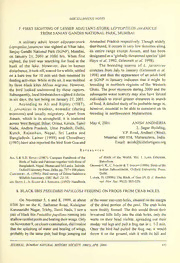
7. First Sighting of Lesser Adjutant stork Leptoptilos Javanicus from Sanjay Gandhi National Park, Mumbai PDF
Preview 7. First Sighting of Lesser Adjutant stork Leptoptilos Javanicus from Sanjay Gandhi National Park, Mumbai
MISCELLANEOUS NOTES FIRST SIGHTING OF LESSER ADJUTANT-STORK LEPTOPTILOS JAVANICUS 7. FROM SANJAY GANDHI NATIONAL PARK, MUMBAI A solitary adult lesser adjutant-stork Arunachal Pradesh respectively. Though widely Leptoptilosjavanicus was sighted at Vihar lake, distributed, it occurs in very low densities along Sanjay Gandhi National Park (SGNP), Mumbai, its entire range except Assam, and has been on January 21, 2001 at 1000 hrs. When first designated as a 'globally threatened species’ (del sighted, the bird was searching for food at the Hoyo et al. 1992; Grimmett et al. 1998). bank of the lake. However, due to human The breeding season of L. javanicus disturbance, it took off, soared for a while, settled stretches from July to January (Grimmett et al. on a bare tree for 10 min and then resumed its 1998) and thus the appearance of an adult bird SGNP feeding activities. While in the air, it was mobbed at in January indicates that it might be by three black kites Milvus migrans. However, breeding in northern regions of the Western the bird looked undeterred by these raptors. Ghats. The poor monsoon during 2000 and the Subsequently, local birdwatchers sighted itthrice subsequent water scarcity may also have forced in six days, the last being on January 27, 2001. individuals to travel greater distances in search A According to Ali and Ripley (1987), offood. detailed study ofits probable range is, L. javanicus is resident, nomadic (during however, essential to be able to comment on its monsoon) and locally migratory. Apart from breeding in northwestern Maharashtra. Assam, which is its stronghold, it is scattered across West Bengal, Bihar, Orissa, Kerala, Tamil May 4, 2001 ANISH ANDHERIA Nadu, Andhra Pradesh, Uttar Pradesh, Delhi, 2, Sagar Building, Kutch, Rajasthan, Nepal, Sri Lanka and V.P. Road, Andheri (West), Bangladesh. Lainer (1999) and Choudhury Mumbai 400 058, Maharashtra, India. (1995) have also reported the bird from Goa and Email: [email protected] Rf.f R E N C E S Ali. S & S.D. Ripley (1987): Compact Handbook ofthe of Birds of the World, Vol. 1. Lynx Edicions, Birds ofIndia and Pakistan together with those of Barcelona. & Bangladesh. Nepal, Bhutan and Sri Lanka. 2ndedn, Grimmett, R., C. Inskipp T. Inskipp (1998): Birds ofthe Oxford University Press, Delhi,pp. 737+ 104plates. Indian Subcontinent. Oxford University Press, Choudhury, A. (1995): Bird survey of Dibru-Saikhowa Delhi. Wildlife Sanctuary. OBCBull. 22: 15. Lainer, H. (1999): The Birds of Goa (Pt I). J. Bombay del Hoyo. J., A. Elliot & .1. Sargatal (1992): Handbook nat. Hist. Soc. 96(2): 203-220. 8. BLACK IBIS PSEUD1BIS PAPULOSA FEEDING ON FROGS FROM CRAB HOLES On November 5, 6 and 8, 1999, at about ofthe water into crab holes, situated on the margin 0700 hrs on the K. Sathanur Road, Kalaignar of the dried portion of the pool. The crab holes Karunanidhi Nagar, Trichy, Tamil Nadu, saw a were freshly formed. The ibis would thrust their I pair ofblack ibis Pseudibispapillosa running into in-curved bills fully into the crab holes, only the shallow rainfed pools and beating theirwings. Only warts on their head visible, spreading out their on November9, on closerexamination, did I realise muddy red legs and pull a frog out in c. 1-2 min. that the splashing of water and beating of wings, Once the bird had pulled the frog out, it would probably by the same pair, had frogs jumping out throw it on the ground, stab it with its bill and JOURNAL, BOMBAY NATURAL HISTORY SOCIETY, 100(1), APR. 2003 111
